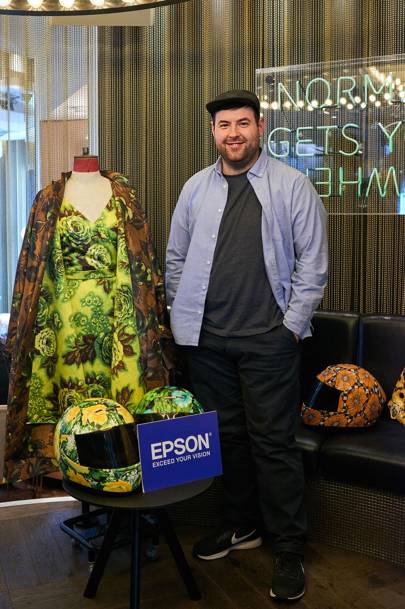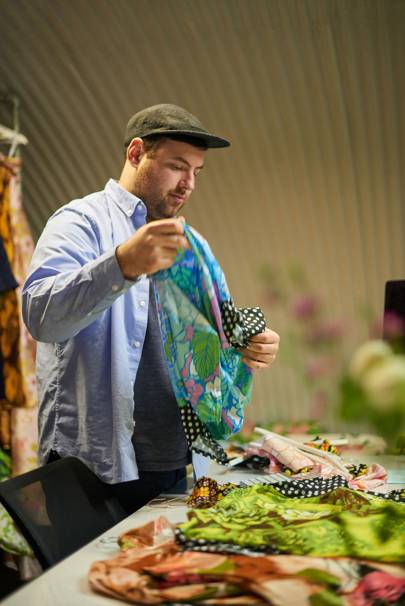It’s a far cry from last month, when the prolific young designer and his team were at the centre of a media maelstrom after the Queen attended his autumn/winter 2018 show at London Fashion Week to present him with the inaugural Queen Elizabeth II Award for British Design. “The press coverage has been a bit nuts since then,” admits Quinn. “Before the show, we were on the radar of people in fashion, but the average person on the street certainly wouldn’t have heard of us. We only had 15 stockists last season and then after the show it rocketed to 45. I didn’t even think the news would be big in the UK, but then my friends in New York called me because they saw my name running across the Fox building.”
Despite the publicity, Quinn insists that nothing has changed about the way he intends to run his business. South London has always been his natural habitat. “I was born in Lewisham and brought up in Eltham. My dad has a scaffolding yard about eight arches up from me. He’s had it since 1996 and I’ve been in this area my whole life. I don’t connect that well with East London - it’s not really my scene, so it feels right to stay here, even after all this attention.”
Did it ever feel overwhelming? “I’m a calm person so I don’t really get starstruck,” he replies. “It was a celebration of the team and the studio and everything we’ve achieved.” He says the best part of the experience was how his parents reacted. “I was told that the Queen was coming three days before the show and I obviously couldn’t tell anyone. On the day, my parents were sitting opposite her, and they were just so shocked. It was even funnier when they met Anna Wintour later on. My mum knew who she was but my dad didn’t. He just nodded at her and said, ‘Alright?’”

For Quinn, the important thing about his recent success is the impact it will have on his studio. He founded the enterprise last year partly out of necessity, having previously struggled to find affordable studio spaces and screen-printing facilities in London. "When I won the H&M Design Award, I had about £45,000 to invest in a studio and I got all the equipment straight away,” he explains. “I wanted a space where I could create my collections all under one roof in a sustainable way, and help other designers do the same. At the time, I was already working with Charles Jeffrey on stuff for his menswear show, so it was great to have a proper workspace.”
Collaboration is key to the ethos of the studio, which functions both as a business for Quinn as well as a hub for emerging talent. His clients include Mimi Wade, Dilara Findikoglu, and Jeffrey alongside bigger fashion houses like Burberry, JW Anderson and Ports 1961. “It’s a great network of people and it’s exciting to have that dialogue with other designers,” says Quinn. In accordance with his vision of inclusivity, students are also welcome to use the services. “It’s something I really wish I’d had when I was studying – then I would have been even more inclined to do print.”
The prints that fill every inch of Quinn’s workspace are striking: floral silk scarves, baroque botanical prints on velour, thigh-high boots in dotted Lycra and ball gowns made of glistening silver foil. “I always wanted to shatter the stereotype and make luxury products from unexpected fabrics,” he says. “Clothes made from polyester, vinyl and viscose are luxurious in their own subversive way.” The challenge for Quinn has been to print onto these complex fabrics without his signature patterns looking diluted. “Digital printing was my solution. I make everything onsite with an Epson textile printer and another machine that produces paper, vinyl and film coverings that can wrap 3D objects.” This technique was useful when it came to creating the floral-printed motorcycle helmets worn by his models in the autumn/winter 2018 show.
Far from being a means to an end, digital printing has completely transformed Quinn’s business. Compared to the traditional textile printing process, it allows him to use up to 70 per cent less water and 80 per cent less energy when creating his garments. The ease with which pieces can be customised also means that retailers can request exclusive design compositions so that no stockist has to carry the exact same item. By producing everything onsite, Quinn can deliver exact quantities to his retailers without any additional waste.
Far from being a means to an end, digital printing has completely transformed Quinn’s business. Compared to the traditional textile printing process, it allows him to use up to 70 per cent less water and 80 per cent less energy when creating his garments. The ease with which pieces can be customised also means that retailers can request exclusive design compositions so that no stockist has to carry the exact same item. By producing everything onsite, Quinn can deliver exact quantities to his retailers without any additional waste.

"Before my BA, there were elements of sustainability in my work, but it wasn’t ingrained in me,” he admits. “I would paint calico to make my garments look like couture dresses, but that was purely because I had no money.” Everything changed when he met Stella McCartney, who saw his graduate collection at Central Saint Martins and offered him a scholarship for an MA. “As a part of the scholarship, she had talks with the university and educated us on waste. It was a really good way of working because the more I was told I couldn’t do certain things, the more resourceful I became. I couldn’t use leather so I developed techniques to counteract it and in the end, the clothes looked better. I don’t think you can be a designer now without being sustainable and socially aware."
2018 is set to be an even busier year for Quinn, but he is adamant that the studio’s principles won’t be compromised. “I’d like for us to employ apprentices and grow locally instead of moving elsewhere and losing control over quality,” he explains. “For now, I’d like to get another arch and physically split the business, so that my line and the open access studio are separated. With the projects we have coming up, we’ll definitely need more space.”
These projects include an exclusive collection designed for Debenhams due to launch in May, an interiors installation at Matchesfashion.com’s private shopping townhouse in Marylebone and possibly even a new homeware line. What is he most excited about? “I’m collaborating with Liberty on a second collection of bags using a patchwork of their archive prints. They’ll come out next month, and I really want to get a cardholder. I think it’s the first thing I’ve made that I can actually own without people being confused,” he says, laughing. “I don’t think I could pull off the scarves.”

No comments:
Post a Comment